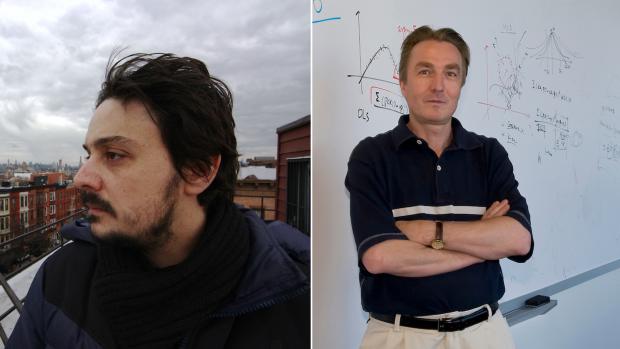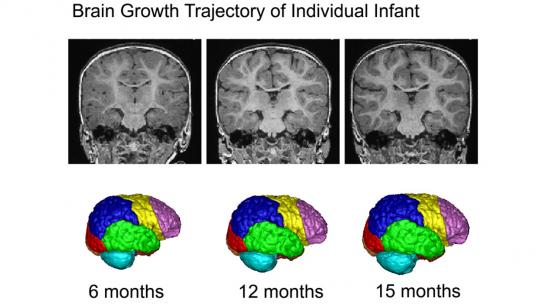IEEE Elects Two NYU Tandon Professors as Fellows
Guido Gerig Honored for Contributions to Medical Image Processing
Maurizio Porfiri Recognized for Research in Biomimetic Robotics

Maurizio Porfiri (left) and Guido Gerig
BROOKLYN, New York, Tuesday, December 11, 2018 – Two faculty members of the NYU Tandon School of Engineering have been elevated to fellows of the Institute of Electrical and Electronics Engineers (IEEE), the world's largest technical professional association.
Guido Gerig, an institute professor and chair of the Department of Computer Science and Engineering, was recognized for the many contributions he has made to medical image processing. He also holds appointments in the NYU Courant Institute for Mathematical Sciences in computer science and NYU Langone Health’s Department of Child and Adolescent Psychiatry, Department of Psychiatry and Department of Radiology. Maurizio Porfiri, a professor in NYU Tandon’s Departments of Mechanical and Aerospace Engineering as well as Biomedical Engineering, was cited for his research in the field of biomimetic robotics.
“Guido Gerig and Maurizio Porfiri are among the most creative faculty members I know,” said NYU Tandon Dean Jelena Kovačević. “Guido is widely acknowledged as being among the world’s foremost authorities in the field of medical image analysis, and his successes in visualizing the mysteries of the human brain have been nothing short of groundbreaking. His seminal work has led to a deeper understanding of how autism can be predicted, how traumatic brain injuries can best be treated, how the normal brain develops, and much more.
“Maurizio’s research interests span a wide range of topics, from dynamical systems theory and applications to multiphysics modeling to mechanics of smart materials and structures, and he also serves as an example to our students as an entrepreneur, having co-founded Manifold Robotics, a startup that employs water-based autonomous vehicles for various applications.
“Their recognition as IEEE Fellows is just the latest in long lists of accolades for both of them, and we at NYU Tandon are privileged to have them as members of our faculty.”
Guido Gerig: Medical Image Processing
Gerig, who is affiliated with Tandon’s Visualization, Image, and Data Analysis (VIDA) Center, has developed image analysis techniques for some of medicine’s most challenging puzzles. His innovative methodologies – many of which are acknowledged to be the first of their kind – have been applied in a number of research studies on anatomical changes due to disease, therapy and recovery, as well as to such specific conditions as schizophrenia, autism, multiple sclerosis, and Huntington's disease.

For example, as part of the Infant Brain Imaging Study, a landmark project funded by the National Institutes of Health (NIH) to identify babies at risk for developing autism, he devised software that analyzed scans produced by Diffusion Tensor Imaging (DTI) to show that infants who later developed the condition exhibited early abnormalities in nerve connectivity. He has also been involved in a project spearheaded by the National Institute on Drug Abuse at the NIH, in which his new MRI imaging and analysis techniques were used to assess the impact of in utero cocaine exposure on infant brain development and to determine the long-term effects of reduced gray matter in infant brains.
Recently, his efforts to quantify 3D dynamic morphological changes in the lamina cribrosa at the rear of the eye, as captured on optical coherence tomography (OCT) scans, has led to a greater understanding of the structural and functional changes that accompany glaucoma and could result in early prediction and diagnosis of the condition, which is the second leading cause of blindness worldwide.
Among his other recent projects:
- Collaboration with an international research group that is using hyperspectral fluorescence microscopy to study macular degeneration, the world’s leading cause of blindness
- Working with researchers at NYU Radiology and the NYU Center for Biomedical Imaging to assess knee and hip cartilage, for early detection of degeneration and to determine the optimal type and timing of therapy
- Analyzing wrist motion using 4D MRI to better understand, diagnose, and treat abnormalities
- Undertaking a five-year NIH-funded examination of school-age children from his earlier autism study, to develop tools for early identification and more timely and effective interventions
- Aiding in a study of Down syndrome, the most common genetic cause of intellectual disability, using cutting-edge MRI technology to examine the shape, function, and connections within the brain, with the goal of better understanding maturation patterns.
Using Gerig’s image analysis tools and methods, which he makes open source and available to all, medical researchers have also made numerous other clinical discoveries, including identifying the factors that make a patient vulnerable to developing schizophrenia and assessing the risk factors for Huntington's disease.
In addition to his recent IEEE Fellowship, Gerig is a fellow of both the American Institute for Medical and Biological Engineering (AIMBE) and the Medical Image Computing and Computer-Assisted Intervention (MICCAI) Society, and he has garnered multiple awards for excellence in teaching.
Maurizio Porfiri: Biomimetic Robotics

As head of Tandon’s Dynamical Systems Laboratory (DSL), Porfiri seeks to improve the understanding of complex dynamical systems. Within this field of investigation, he aspires to close the loop between engineering and nature through the use of biomimetic robotic fish, which can be deployed alongside live fish to clarify the drivers of behaviors related to fear, leadership, social cueing, courtship, and more.
Recently, Porfiri and his collaborators used advanced tracking software to design and test the first-ever closed-loop control system featuring a bio-inspired robotic replica interacting in three dimensions with live zebrafish. The system allows the robotic replica to “watch” and mimic the behavior of live zebrafish in real time. This broadened research possibilities, as the real fish showed greater affinity and no signs of anxiety or fear toward a robotic replica that mirrored its own behavior, rather than a robot that followed a pre-set pattern of swimming as in previous studies. Through support from the National Science Foundation (NSF) and the NIH, his robotic fish are being used to establish robust methodologies to identify causal relationships in animal behavior and to understand the effect of substance abuse on individual and social behavior.
Porfiri’s work with biomimetic robotic fish led to his inclusion on Popular Science’s annual roundup of the most promising young scientists, the Brilliant 10, in 2010, with the magazine dubbing him the “Water Wizard.” He has also garnered an NSF Faculty Early Career Development Program (CAREER) award, as well as several honors from ASME (founded as the American Society of Mechanical Engineers), including the organization’s C.D. Mote Jr. Early Career Award, for his work on collective behavior, active materials for biomimetic propulsion, and fluid-structure interactions.
Porfiri – who has earned degrees from the University of Rome ‘‘La Sapienza,’’ the University of Toulon, and Virginia Tech – is the author of more than 250 journal publications, and his work has been featured in such high-profile media outlets as CNN, NPR, and the Discovery Channel. In addition to his Tandon appointments in the Departments of Biomedical Engineering and Mechanical and Aerospace Engineering, he is an associated faculty member in the Department of Civil and Urban Engineering.
Note: Images available for download
About the New York University Tandon School of Engineering
The NYU Tandon School of Engineering dates to 1854, the founding date for both the New York University School of Civil Engineering and Architecture and the Brooklyn Collegiate and Polytechnic Institute (widely known as Brooklyn Poly). A January 2014 merger created a comprehensive school of education and research in engineering and applied sciences, rooted in a tradition of invention and entrepreneurship and dedicated to furthering technology in service to society. In addition to its main location in Brooklyn, NYU Tandon collaborates with other schools within NYU, one of the country’s foremost private research universities, and is closely connected to engineering programs at NYU Abu Dhabi and NYU Shanghai. It operates Future Labs focused on start-up businesses in downtown Manhattan and Brooklyn and an award-winning online graduate program. For more information, visit http://engineering.nyu.edu




